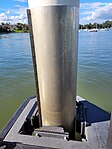| This article needs additional citations for verification. Please help improve this article by adding citations to reliable sources. Unsourced material may be challenged and removed. Find sources: "Floating dock" jetty – news · newspapers · books · scholar · JSTOR (October 2023) (Learn how and when to remove this message) |
A floating dock, floating pier or floating jetty is a platform or ramp supported by pontoons. It is usually joined to the shore with a gangway. The pier is usually held in place by vertical poles referred to as pilings, which are embedded in the seafloor or by anchored cables. Frequently used in marinas, this type of pier maintains a fixed vertical relationship to watercraft secured to it, independent of tidal, river or lake elevation. The angle of the gangway varies with the water level.
Braby pontoon
'Braby pontoon' was the name given to a type of floating dock used by flying boats in Australia and New Zealand from 1939 to the 1950s. Frederick Braby and Company was a British manufacturer of tanks and silos, Bailey bridges and pontoons. The Braby name was also attached to the general type of pontoon made with ship tanks, whether or not they were manufactured by Frederick Braby and Company. Two 1939 descriptions of a Braby pontoon in Auckland stated:
A new type of floating jetty will he used in Auckland for the berthing of the flying-boats. Mr. Turnill stated this morning that this type is known as the "Braby pontoon", and it has been used previously only at Southampton. It has been well tested there and has been found to be most satisfactory. It consists of two twin sections joined in an arc underneath the water.
and
Shaped like a U, the pontoon resembles a miniature floating dock, and consists of two parallel decks joined by a submerged framework. Tanks give the necessary buoyancy. When the flying-boat has landed, it is warped into position by the ground crew, and is drawn tail-first into the pontoon, coming to rest with the hull between the two sections of decking and above the submerged frame. Inflated buffers on the inner edge of the decking prevent the delicate hull from being damaged.
A Braby pontoon constructed at Evans Bay in Wellington, New Zealand in 1951 consisted of 124 large square steel tanks connected together and ballasted with water and oil. The pontoon was U-shaped, 110 feet (34 m) long and 74 feet (23 m) wide. Flying boats were winched tail-first into the U so that passengers could step onto the pontoon dock.
-
 A Braby pontoon at Evans Bay, Wellington, New Zealand.
A Braby pontoon at Evans Bay, Wellington, New Zealand.
-
 A floating dock at Mohonk Mountain House
A floating dock at Mohonk Mountain House
-
 A floating dock at Florence Marina State Park
A floating dock at Florence Marina State Park
-
 A floating dock at a private marina. The vertical "spud" only anchors the dock sections in place, and does not provide structural support for loads upon the dock.
A floating dock at a private marina. The vertical "spud" only anchors the dock sections in place, and does not provide structural support for loads upon the dock.
-
 A pontoon in Sydney
A pontoon in Sydney
See also
- Gaza floating pier, a floating pier built during the Israel–Hamas war
- Floating dock (impounded), other types of floating docks
- Floating dry dock, other types of floating docks
Reference
- James F. Wilson (2010). "Passive Restraint System for Floating Docks with Large Water-Level Excursions". Practice Periodical on Structural Design and Construction. 15 (4): 294–97.
- ^ "Tasman Airway". New Zealand Herald. 11 May 1939 – via Papers Past.
- "£10,000 Repairs for Flying Boat". The Courier-mail. No. 4543. Queensland, Australia. 20 June 1951. p. 3. Retrieved 15 November 2023 – via National Library of Australia.
- "Braby's pick Sales Chief". Western Daily Press. 21 September 1966. p. 2. Retrieved 16 November 2023 – via British Newspaper Archive.
Mr Rhodes joined Braby in 1931 as a design draughtsman. During the war, he was responsible for Bailey bridge building and the design and building of servicing pontoons for use with Sunderland flying boats.
- Pearson, Michael (1992). "From Ship to the Bush: Ship Tanks in Australia" (PDF). Australasian Historical Archaeology. 10: 24–29 – via eHive.
- The Braby pontoon built at Wellington, New Zealand in 1951 was constructed locally from re-used tanks.
- "£16,000 berth for Solent". Evening Post. 23 August 1951. p. 57 – via Wellington City Archives.
- "How soon now?". Auckland Star. 16 March 1939 – via Papers Past.
- "Flying boat pontoon". Press. 25 September 1951. p. 6 – via Papers Past.
- "Big moving contract". Press. 2 February 1957 – via Papers Past.